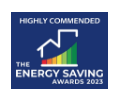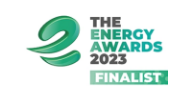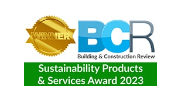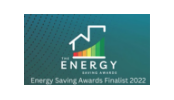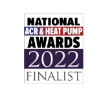Discover how Adveco can combine packaged electric water heating and solar thermal – solar FUSION – for low-carbon commercial water heating…
Whether new build or retrofit, the application of solar thermal pre-heat is a well-established means of reducing the energy demands of domestic hot water (DHW) applications, offsetting operational costs and actively cutting carbon each year by 148 kg of CO₂ per m² of collector installed on a building. Traditionally, such a system would have employed gas-fired water heating to top up for peak and unexpected demands, especially outside of the summer months. Today, as buildings transition to all-electric water heating to address decarbonisation, the integration of solar thermal with more costly-to-operate electric DHW applications is even more advantageous.
Adding extra elements to DHW systems increases the complexity, especially in commercial buildings, leading to the need for bespoke system design, which inherently adds capital costs that can exclude those organisations with low- to mid-capacity DHW demands. That is changing with the application of Adveco’s award-winning FUSION electric water heating system, which incorporates cylinder, electric boiler and controls.
Designed as a simple, cost-effective means for transitioning to fully electric, low-carbon water heating. FUSION T offers a twin-coil stainless steel tank variant which, although designed for heat pump integration, allows for the introduction of solar thermal energy into the lower coil as the system preheat. This option is enabled with a small amendment to the controls to optimise top-up heating from the boiler as the pre-heat fluctuates across the year. This creates a ‘solar FUSION’ system variant.
Well-designed commercial solar thermal systems are capable of offsetting on average a minimum of 30% of the energy demands for water heating, making it potentially ideal for organisations that require regular DHW. For some UK regions, especially in the South and West, this percentage is much higher. In the summer months, solar can potentially meet all of a DHW system’s energy demands, especially in the case of smaller commercial businesses and offices.
A south-facing and unobstructed roof with an inclination of 30° from the horizontal is optimal, but Adveco recognises that small- to mid-sized organisations are likely to also struggle with space for the installation of solar collectors. In response, its modular, high-performance flat plate collectors can be situated on or integrated into flat or sloped roofs, as well as mounted on a building’s façade. By far the most efficient way to heat water with solar energy, flat plate collectors also offer a smaller footprint compared to equivalent solar photovoltaics (PV) for DHW. A typical office may require, as a rule of thumb, one solar thermal collector per 100 litres of thermal storage capacity.
Most commercial applications average six to 20 collectors, and with a single FUSION capable of supporting capacities up to 750 litres with 24 kW heat output, this places it firmly in the lower spectrum demand for collectors. While solar thermal systems will typically be designed to evenly split capacity between the preheater and after heater, this single-cylinder FUSION scenario uses Adveco’s smart controls to ‘cheat’ the system in favour of the solar thermal input. Adveco can deliver a 600-litre solar capacity application in a 750-litre tank for an extremely compact all-electric, low-carbon emission, solar water heating system with a minimal rooftop or façade footprint.
Adveco will also specify Drain Back modules with the collectors to preserve the operational qualities of the solar fluid, adding further resilience to the solar function in line with the robust, protective operation of the FUSION system. FUSION is resilient to limescale formation in hard water areas, common in the South and South-East where solar is also optimal and incorporates multiple, balanced heating elements built-in and the option of an immersion back-up for no single point of failure.
Integrating FUSION packaged electric water heating with solar thermal is one of the most cost-effective and simple ways of introducing hybrid DHW into smaller commercial buildings. For larger applications, FUSION can still be integrated into more bespoke alternatives that not only harness solar thermal but optimise the use of air source heat pumps to provide the initial pre-heat for the system.
Operating at lower temperatures with the cold feed maximises the efficiency of the heat pump, reducing electrical operating costs and raising working flow temperatures from 10°C to 40°C. This is not hot enough for commercial applications, so the pre-heated water is passed to a mid-solar thermal system. Essentially free to operate, the solar thermal system boosts the working flow temperatures from 40°C to at least 50°C. Although not operating at maximum potential, there is enough advantage gained from solar thermal to warrant the additional system complexity and capital investment. During summer months the solar thermal system can deliver the necessary 60°C working flow for safe provision of commercial hot water. But to ensure safe, consistent, and necessary high operational temperatures, the water is passed to the FUSION unit, where the electric boiler ensures consistent water temperatures of up to 65°C are available year-round.
For many organisations, the transition to electric water heating is a major decision, but solar FUSION also offers the means to advance more slowly at a pace that meets wider sustainability goals. Some organisations have already opted to install basic FUSION systems to deliver electric-only heating, but although not ready to embrace pre-heat variants still want the option to adapt systems at a later date. In this case, they have opted to integrate FUSION with the dual coil ATST cylinder option. The ARDENT boiler is plumbed into the lower coil, and the upper coil is initially not used. Should thinking change or budget allow at a later stage, it is a simple replumbing activity to switch the ARDENT boiler input to the upper coil and adjust controls to introduce solar thermal preheat. Organisations using this approach gain a futureproof system that can deliver the advantages of solar FUSION – or opt for an air source heat pump preheat – at a time that suits their developing sustainability goals without the costly need to purchase a further cylinder or boiler.








